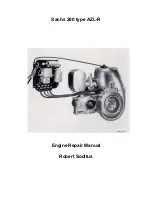
5
ENGLISH
OPERATION
SAFE OPERATING PRECAUTIONS
Before operating the engine for the first time, please review the
SAFETY MESSAGES
and the
BEFORE OPERATION CHECKS
For your safety, do not operate the engine in an enclosed area such
as a garage. Your engine's exhaust contains poisonous carbon
monoxide gas that can collect rapidly in an enclosed area and cause
illness or death.
Review the instructions provided with the equipment powered by this
engine for any safety precautions that should be observed with
engine startup, shutdown, or operation.
Do not operate the engine on slopes greater than 15° (26%).
FREQUENCY OF USE
If your equipment will be used on an infrequent or intermittent basis
(more than 4 weeks between usage), refer to the
Fuel
section of the
STORAGE
chapter (page 8) for additional information regarding fuel
deterioration.
STARTING/STOPPING THE ENGINE
Engine speed
: For best engine performance, it is recommended
the engine be operated with the throttle in the FAST (or high)
position.
• Restarting:
To ensure easy restarting and maximum performance
from the Auto Choke System types, allow the engine to run for at
least three minutes after starting a cold engine before stopping the
engine. This minimum run time will be longer if the temperature is
below 21°C.
STARTING THE ENGINE
1. Turn the fuel valve [1] to the ON position before starting the
engine.
2. Move the flywheel brake lever* [2] to the RUN position.
3. Pull the starter grip lightly until resistance is felt; then pull briskly.
NOTICE
Do not allow the starter grip to snap back against the engine.
Return it gently to prevent damage to the starter.
STOPPING THE ENGINE
1. Release the flywheel brake lever* [2] to stop the engine.
2. After stopping the engine, turn the fuel valve [1] to the OFF
position.
* See the equipment manual for control location.
SERVICING YOUR ENGINE
THE IMPORTANCE OF MAINTENANCE
Good maintenance is essential for safe, economical, and trouble-free
operation. It will also help reduce pollution.
To help you properly care for your engine, the following pages include
a maintenance schedule, routine inspection procedures, and simple
maintenance procedures using basic hand tools. Other service tasks
that are more difficult, or require special tools, are best handled by
professionals and are normally performed by a Honda technician or
other qualified mechanic.
The maintenance schedule applies to normal operating conditions. If
you operate your engine under severe conditions, such as sustained
high-load or high-temperature operation, or use in unusually wet or
dusty conditions, consult your servicing dealer for recommendations
applicable to your individual needs and use.
Remember that an authorized Honda servicing dealer knows your
engine best and is fully equipped to maintain and repair it.
To ensure the best quality and reliability, use only new Honda
Genuine parts or their equivalents for repair and replacement.
MAINTENANCE SAFETY
Some of the most important safety precautions follow. However, we
cannot warn you of every conceivable hazard that can arise in
performing maintenance. Only you can decide whether or not you
should perform a given task.
SAFETY PRECAUTIONS
• Make sure the engine is off before you begin any maintenance or
repairs. This will eliminate several potential hazards:
–
Carbon monoxide poisoning from engine exhaust.
Be sure there is adequate ventilation whenever you operate
the engine.
–
Burns from hot parts.
Let the engine and exhaust system cool before touching.
–
Injury from moving parts.
Do not run the engine unless instructed to do so.
• Read the instructions before you begin, and make sure you have
the tools and skills required.
• To reduce the possibility of fire or explosion, be careful when
working around petrol. Use only a nonflammable solvent, not
petrol, to clean parts. Keep cigarettes, sparks, and flames away
from all fuel related parts.
WARNING
Exhaust contains poisonous carbon monoxide gas that can build
up to dangerous levels in closed areas. Breathing carbon
monoxide can cause unconsciousness or death.
Never run the engine in a closed or even partially closed area
where people may be present.
WARNING
Improper maintenance, or failure to correct a problem before
operation, can cause a malfunction in which you can be
seriously hurt or killed.
Always follow the inspection and maintenance
recommendations and schedules in this Owner’s Manual.
WARNING
Failure to properly follow maintenance instructions and
precautions can cause you to be seriously hurt or killed.
Always follow the procedures and precautions in this Owner’s
Manual.
Summary of Contents for GCV170
Page 44: ...44 ITALIANO ...
Page 61: ...61 ...
Page 62: ...62 ...
Page 63: ...63 ...
Page 64: ......






































